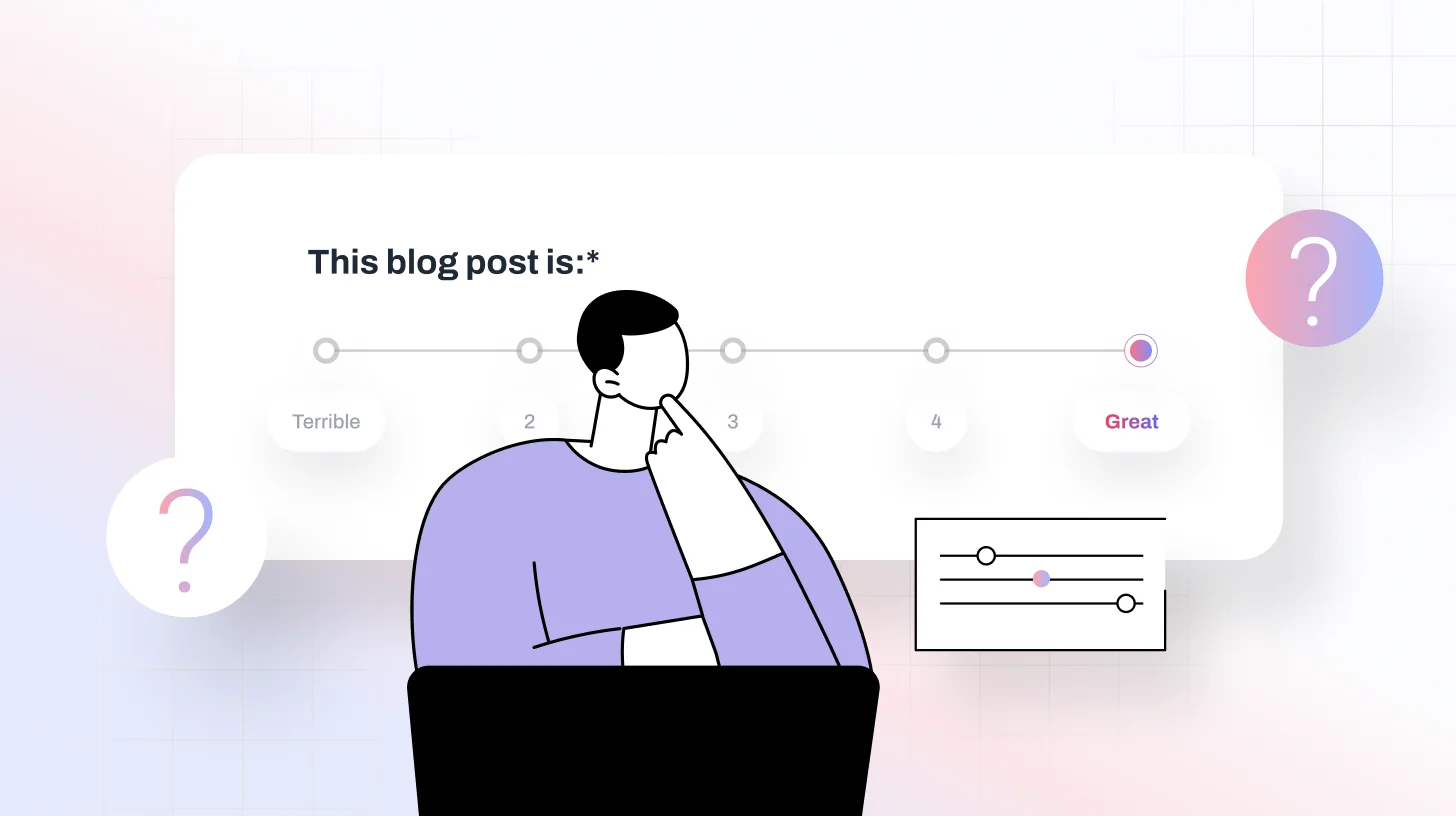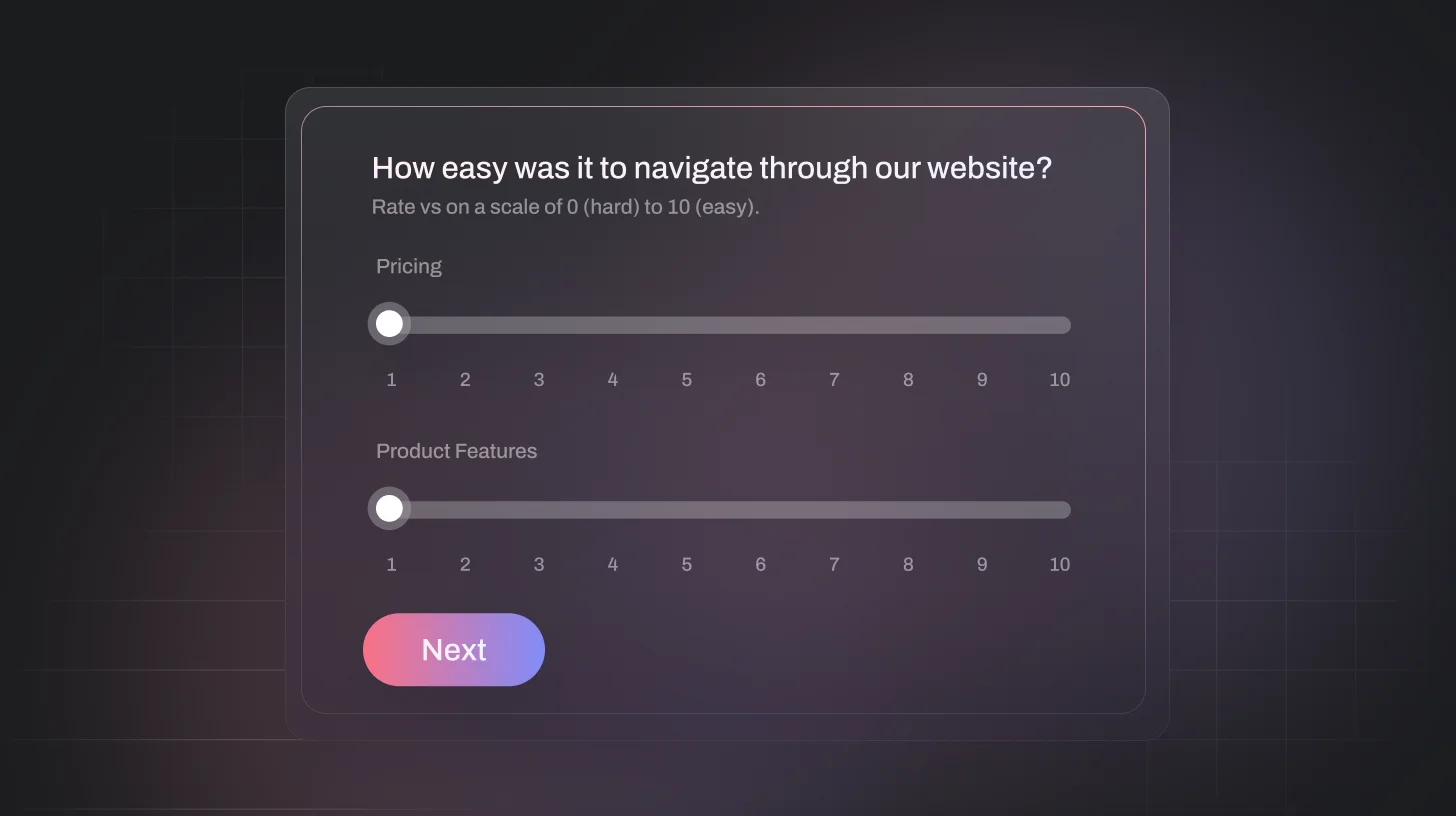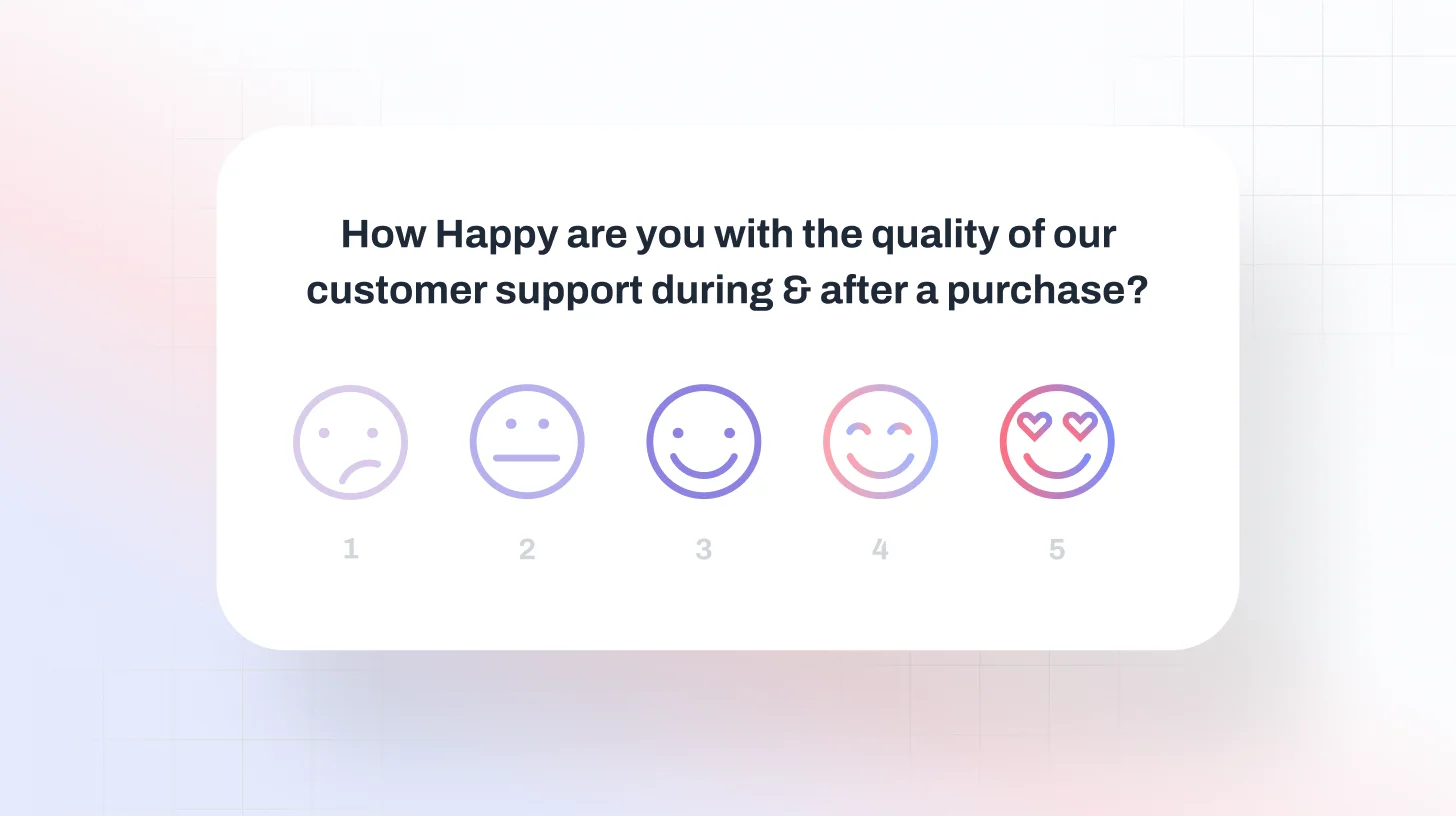 Blog
Blog What is the Semantic Differential Scale? Definition, Types, and Examples
What is the Semantic Differential Scale? Definition, Types, and ExamplesWhat is the Semantic Differential Scale? Definition, Types, and Examples

Remember those quick sliders that pop up after you use an app, asking you to choose between easy–hard or love it–hate it? That’s the semantic differential scale in its simplest form. It goes beyond basic satisfaction and taps into how users genuinely feel.
If you want to measure emotional feedback, not just surface-level opinions, semantic differential scales are your best tool.
Short Summary
A semantic differential scale is a modern, perception-based survey method that helps teams understand how people feel. Unlike traditional Likert scales that measure agreement, it uses pairs of opposite adjectives like easy–hard or modern–outdated to reveal emotional nuance and depth. For B2B SaaS teams, it’s a faster, more engaging way to capture feedback that actually drives decisions. From UX and customer experience to branding, HR, and education, semantic scales translate subjective feelings into clear, actionable insights. When designed thoughtfully and paired with AI analysis, they turn raw feedback into real foresight.
What is a Semantic Differential Scale?
A semantic differential scale is a survey rating scale that measures how people feel about a product, service, or experience using multiple-point options between two opposite descriptors. Respondents select a position between the two ends, revealing both the intensity and direction of their perception. It’s similar to a 1–5 or 1–10 Likert scale, but instead of numbers, it uses pairs of contrasting words to define the spectrum.
Developed by American social psychologist Charles Osgood in the 1950s, the semantic differential scale captures attitudes by placing opposite adjectives on each end, for example, helpful–unhelpful, modern–outdated, or easy to use–hard to use. Respondents mark where they fall between the two, offering a clear and accurate view of their perceptions without relying on subjective numerical labels.
Core Elements of a Semantic Differential Scale
- Bipolar adjective pairs
- A continuous scale (usually 5–9 points)
- Directional sentiment (positive → negative or vice versa)
- Comparative perception instead of agreement-based scoring
This method sits at the intersection of psychology, UX research, and modern CX analytics, making it ideal for product teams and CS leaders who need crisp sentiment data without survey fatigue.
Types of Semantic Differential Scale Questions
Here are the most common types of semantic differential scale questions used in surveys today:
Slider rating scale
This semantic differential scale type is closest to capturing what humans actually think. It’s more interactive and visual than a traditional numbered scale, allowing respondents to move fluidly between two opposite adjectives and express nuances that rigid scales often miss.
Examples
Easy ——————————————— Hard
Modern ——————————————— Outdated
Powerful ——————————————— Limited

Non-slider rating scale
Instead of sliders, this type of semantic differential scale uses clickable radio buttons. Each option stands on its own, so respondents pick just one that feels right. If they change their mind, selecting another automatically updates their choice. It’s simple, clean, and easy to analyze.

Open-ended questions
Open-ended questions provide ample space for respondents to express their thoughts truly. They turn simple feedback into richer insights, especially when paired with AI that clusters themes and sentiments.
Example
“What made this feel intuitive or confusing for you?”
[ Blank Space]
Ordering
In an ordering question (also called a rank-order question), respondents rank the options according to how well each fits a specific variable or experience.
Example
Which of these experience qualities best describes how you felt while using our platform?
Drag and drop to rank each one from MOST accurate to LEAST accurate.
- Ease of Use
- Speed of the Experience
- Reliability
- Overall Helpfulness

Satisfaction rating
One of the easiest and most user-friendly types of semantic differential scale questions is the satisfaction rating. It feels familiar, it’s quick to answer, and it clearly shows how satisfied or dissatisfied someone felt without making them overthink their response.

Read: What are Multiple Choice Questions in Surveys?
Why B2B SaaS Teams Should Use Semantic Differential Scale
Capture the nuance that traditional ratings miss
Most SaaS surveys rely on Likert statements like “The product is easy to use.” But “agree” means something different to every customer shaped by their background, expectations, tech maturity, and even culture. It’s subjective, and it dilutes your signal.
Semantic differential scales cut through that ambiguity:
Easy ——————————————— Hard
Instead of reacting to a statement, customers evaluate an attribute. This gives Product and CS teams a much sharper read on what’s actually happening in the experience, not just how customers feel about a sentence on a survey.
Get Higher Response Rates
Customers think in impressions. Opposing adjectives tap directly into that instinct. They’re visual, quick, and require almost zero cognitive load. Your users aren’t slogging through a form. They’re simply placing themselves on a spectrum that already feels familiar.
And in SaaS, where engagement is everything, a frictionless survey often means the difference between hearing from 10% of your users and hearing from 40%+.
Generate stronger signals for NPS, CSAT, and health scores
Semantic differential scales feed directly into the metrics SaaS companies care about most. They deepen the signal behind:
- Customer health scoring
- Onboarding effectiveness
- Feature adoption quality
- Perceived value
- Emotional drivers of churn
- Brand and experience perception
This isn’t just better data, it's more predictive data. And when layered with AI platforms like TheySaid, the system can automatically cluster themes, spot churn signals early, and summarize sentiment patterns across accounts and segments. Sign up for free!
Recommended Read: CSAT vs NPS: Which Customer Experience Metric Actually Works?
Fit Perfectly Into AI-driven Conversational Surveys
Modern feedback is shifting away from static forms and toward natural conversation. Semantic differential scales slide seamlessly into that experience:
“Was this workflow more intuitive or more confusing? Pick where you fall between the two.”
AI takes the placement, interprets intent, and continues the conversation with a tailored follow-up:
“Got it — what felt confusing about it?”
This transforms a simple rating into meaningful context, and meaningful context into actions that Product and CS teams can take immediately.
Semantic Differential Scale vs. Likert Scale
Here’s a quick difference between the semantic differential scale and the Likert scale.
Recommended Read: Likert Scale: The Complete Guide
Applications of the Semantic Differential Scale in Various Fields
The strength of the semantic differential scale lies in its flexibility. Because they measure perception, not just agreement, they can be applied across almost any industry or research context, from customer experience to product design to brand strategy. Here are some key ways they’re used:
Marketing & Branding: To measure how audiences feel about a brand, modern or outdated, trustworthy or uncertain, premium or basic. These insights help shape messaging, positioning, and creative strategy.
Product & UX Research: To assess usability and design perception. Scales like intuitive–confusing or fast–slow reveal how real users experience your product beyond what standard satisfaction scores show.
Customer Experience (CX): To understand the emotional side of customer journeys, for example, whether onboarding felt smooth, frustrating, or support felt helpful or unhelpful.
Employee Feedback & Culture: Many HR and leadership teams use these scales to measure how employees perceive company culture, leadership, or engagement as supportive–unsupportive, transparent–unclear, motivating–draining.
Education & Training: Educators and training teams use semantic scales to evaluate course effectiveness, instructor performance, or student engagement levels.
Healthcare & Public Services: To understand patient or user perceptions around care quality, accessibility, or communication, caring–indifferent, organized–chaotic.
Recommended Read: How Medical Surveys for Patients Are Improving Healthcare
Advantages of the Semantic Differential Scale
- More expressive than Likert scales: Instead of simply agreeing or disagreeing, respondents position themselves between two opposite adjectives, offering richer emotional insight.
- Language-driven clarity: The use of polar adjectives (like simple–complex or innovative–outdated) helps people respond more naturally and precisely.
- Captures nuance: It reflects subtle differences in opinion, revealing how users truly perceive a product, experience, or brand.
- Higher-quality data: Because responses are more specific and contextual, teams can make sharper, more confident business decisions.
- More engaging: The format feels more visual and interactive, which can improve response rates and reduce survey fatigue.
Disadvantages of the Semantic Differential Scale
- Subjective interpretation: Different people may understand adjectives differently, which can affect consistency in responses.
- Takes more effort to design: Crafting balanced adjective pairs requires time and testing to avoid bias.
- Context sensitivity: Recent experiences or timing can influence how users rate between two extremes.
- Not ideal for every topic: Some complex attitudes or behaviors are hard to capture with simple opposites.
How to Make an Effective Semantic Scale Questionnaire
Creating a good semantic scale questionnaire is all about clarity and simplicity. You’re trying to understand how customers feel, so your wording needs to be natural and easy to relate to.
A few ways to get it right:
- Start with your goal. Know exactly what you’re measuring: usability, brand trust, experience, or something else.
- Pick clear, balanced opposites. Adjectives like easy–hard or modern–outdated make sense instantly. Avoid complicated or vague wording.
- Keep the scale consistent. Use the same 5- or 7-point range throughout your survey to make results easier to read.
- Make it visual. Sliders or conversational formats feel lighter and more engaging than static options.
- Test it first. Run a quick pilot with a few users to see if your adjectives make sense to everyone.
- Add space for open feedback. Let people explain why they chose a certain point on the scale; that’s where the real gold lies.
When to Use the Semantic Differential Scale?
Use a semantic differential scale when you care about how customers perceive your product or brand, not just if they’re satisfied. It’s best for measuring emotion, tone, and overall experience, things that numbers alone can’t explain.
It works especially well when you want to:
- Understand how customers feel about your product
- Track brand perception over time
- Measure the onboarding or support experience
- Compare how users see different features or updates
- Get a sense of the emotional drivers behind loyalty or churn
How TheySaid Turns Semantic Differential Scale into Actionable Intelligence
TheySaid is built for modern, customer-obsessed teams that want more than survey data; they want clarity, context, and action. By combining the simplicity of semantic differential scales with powerful AI, TheySaid transforms how organizations capture and understand feedback.
Conversational AI That Feels Human: TheySaid reimagines surveys as conversations. Instead of ticking boxes, respondents engage naturally, giving honest, thoughtful input that feels effortless.
Smart Follow-Ups That Go Deeper: When someone chooses “Hard” over “Easy,” TheySaid doesn’t stop there. It instantly asks, “What made it feel hard?” turning surface-level feedback into meaningful insight.
AI-Powered Thematic Clustering: Behind the scenes, TheySaid’s AI organizes responses into clear categories like product friction, UX issues, or onboarding challenges, helping teams spot patterns at scale.
Executive-Ready Summaries: TheySaid delivers automated summaries that show:
What’s trending, what’s breaking, what needs attention, and which accounts require proactive outreach.
Try TheySaid, your AI-powered feedback engine that helps you listen smarter, uncover insights faster, and take action instantly.
FAQs
What exactly is a semantic differential scale, and how does it work?
A semantic differential scale measures attitudes using two opposing adjectives (like Modern Outdated). Respondents choose where they fall between them, giving richer insight into how they truly feel about a product, feature, or brand.
What are the main types of semantic differential scale questions?
Common types include slider rating scales, non-slider scales (radio buttons), open-ended questions, ordering options, and satisfaction ratings — each offering different levels of interactivity and detail.
How is a semantic differential scale different from a Likert scale?
Unlike Likert scales, which measure agreement with statements (“I agree that the app is user-friendly”), semantic differential scales measure perception directly between opposites (“Easy — Hard”), reducing bias and capturing more nuance.
















.svg)